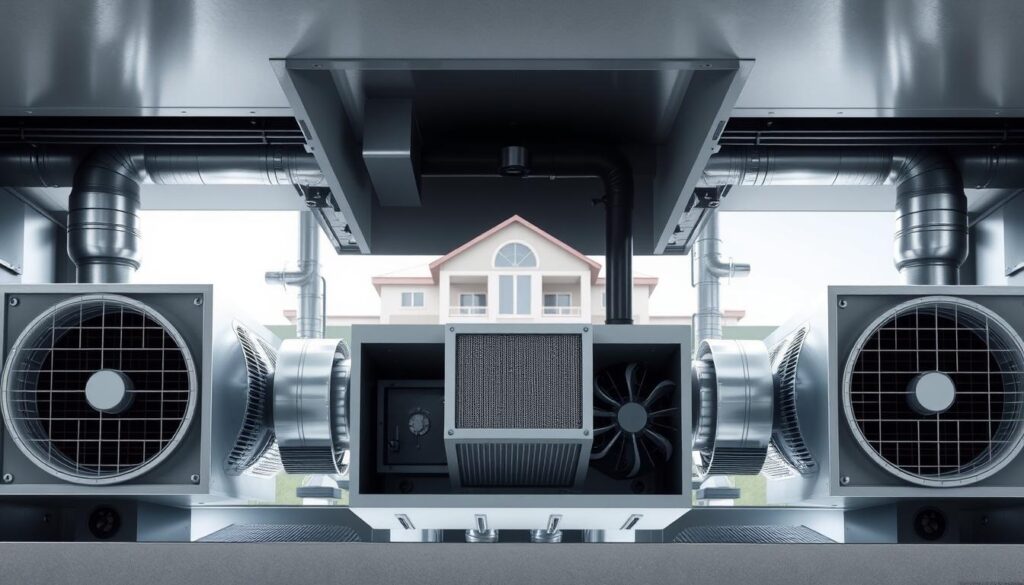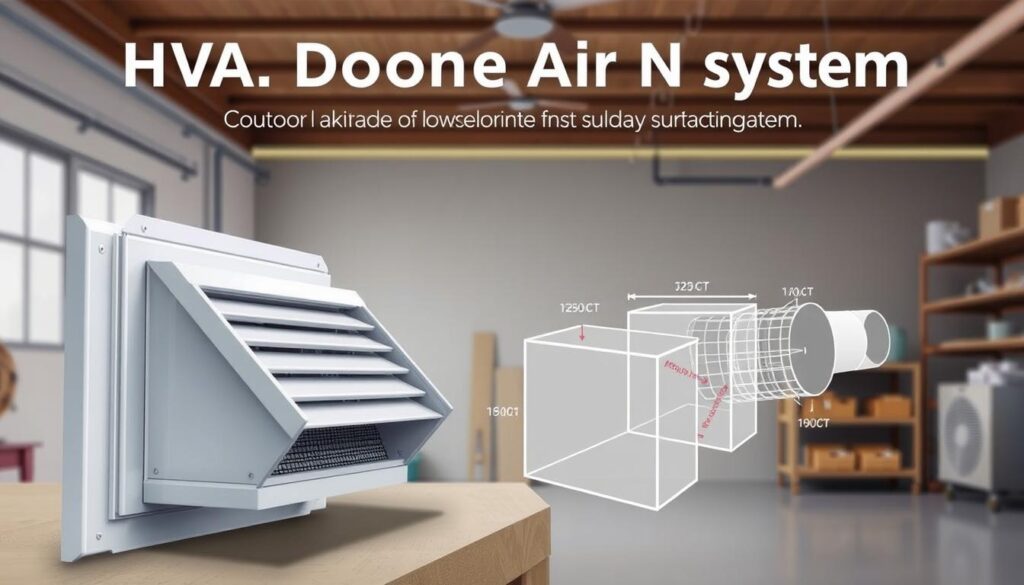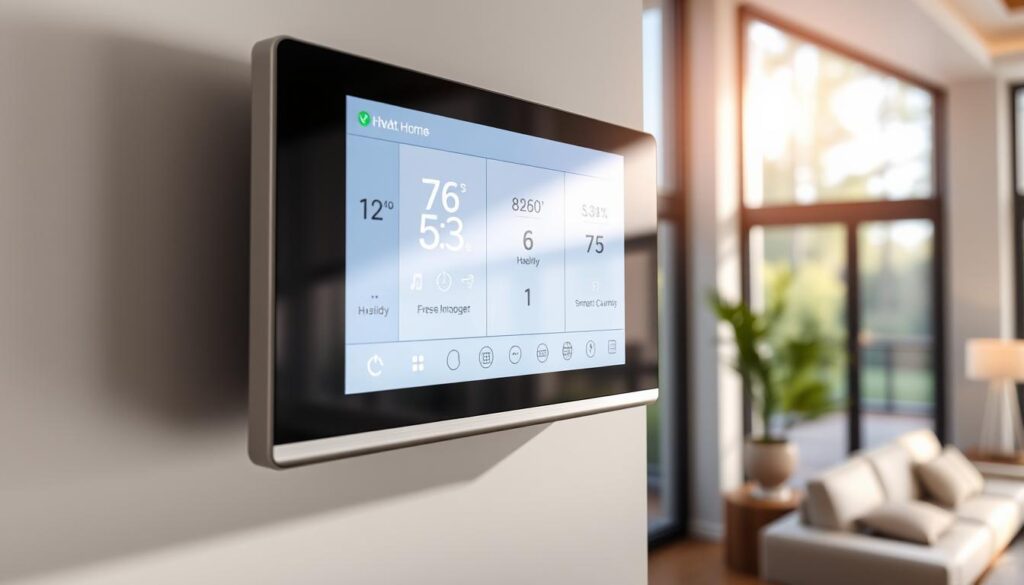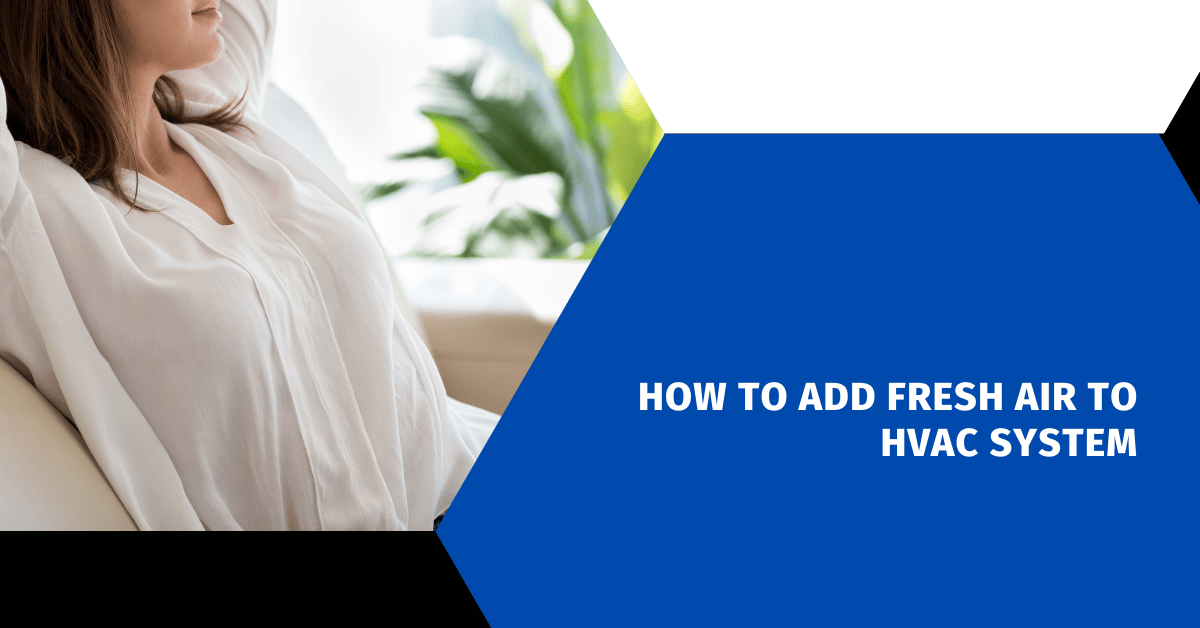Affiliate Disclosure
HVAC Guide Guys is a participant in the Amazon Services LLC Associates Program, an affiliate advertising program designed to provide a means for sites to earn advertising fees by advertising and linking to Amazon.
How to Add Fresh Air to HVAC System? Are you stuck breathing the same stale air every day at home? Your HVAC system might be quietly harming your indoor air quality. Learning how to add fresh air to HVAC systems can change your home and keep your family healthy.

Indoor air can be much dirtier than outdoor air. The Environmental Protection Agency (EPA) says we need certain air exchange rates for a healthy home. By making your HVAC system better at bringing in fresh air, you can make your home healthier and more comfortable.
Adding fresh air isn’t just about feeling better—it’s about making your home safer and easier to breathe. This guide will show you how to make your HVAC system better at bringing in clean air.
Key Takeaways
- Fresh air integration is crucial for maintaining healthy indoor environments
- EPA recommends specific air exchange rates for optimal air quality
- HVAC systems can be modified to improve air circulation
- Proper ventilation reduces indoor air pollutants
- Regular maintenance ensures effective fresh air intake
Table of Contents
Understanding the Importance of Fresh Air Ventilation in HVAC Systems
Your home’s air quality is more critical than you might realize. Increasing ventilation in HVAC systems is key to a healthy home. The air inside can be up to five times more polluted than outside air. So, proper ventilation is vital for your health.
The idea of dilution ventilation is key to good indoor air. It means replacing stale air with fresh air from outside. This helps lower pollutant levels and improves air quality.
Benefits of Proper Ventilation
- Reduces indoor air pollutants
- Minimizes moisture and mold growth
- Eliminates harmful volatile organic compounds (VOCs)
- Improves overall respiratory health
EPA Recommendations for Air Changes
The Environmental Protection Agency has guidelines for air exchange rates. Your HVAC system’s outdoor air intake should meet these standards.
| Space Type | Recommended Air Changes per Hour |
|---|---|
| Residential Spaces | 0.35 – 1.5 |
| Office Buildings | 1.0 – 2.0 |
| Healthcare Facilities | 2.0 – 6.0 |
Impact on Indoor Air Quality
“Clean air is not a luxury, it’s a necessity for human health and well-being.” – Indoor Air Quality Expert
Proper ventilation does more than just move air. It creates a healthier space by removing harmful substances and allergens. It ensures a constant flow of fresh, clean air in your home or office.
Different Methods of HVAC Fresh Air Integration
There are several ways to add fresh air to your HVAC system. The best method can greatly improve your indoor air quality. It also makes your ventilation more efficient. The right choice depends on your home’s needs.
Homeowners have many options for fresh air in their HVAC systems. The most common include:
- Motorized Damper Systems
- Energy Recovery Ventilators (ERVs)
- Dedicated Outdoor Air Systems (DOAS)
- Makeup Air Units
A motorized damper is a simple way to control air exchange. It opens and closes to let in fresh air. It’s often recommended for smaller homes where air control is key.
Energy Recovery Ventilators are more advanced. They bring in fresh air and also transfer heat and moisture. This makes them very energy-efficient.
When picking an air intake method, think about:
- Home size
- Climate
- Current HVAC setup
- What you can afford
Each method has its own benefits. Talking to an HVAC expert can help find the best fit for your home.
Explore Our HVAC Shop
Looking for top-rated HVAC tools, parts, and accessories? Visit our shop and find the perfect solution for your needs.
Visit the ShopHow to Add Fresh Air to HVAC: Step-by-Step Guide
Improving your home’s air quality is important. You need to plan and execute carefully. Adding fresh air to your HVAC system involves several key steps.
First, understand your HVAC system’s current state. This guide will help you add fresh air ventilation successfully.
Assessing Your Current System
Start by evaluating your HVAC setup. Look at these important factors:
- Age of current HVAC system
- Existing ductwork configuration
- Home square footage
- Local climate conditions
Choosing the Right Components
Choosing the right components for fresh air intake is crucial. Consider these variables:
| Component Type | Best For | Performance Rating |
|---|---|---|
| Mechanical Ventilation Damper | Small to Medium Homes | Good |
| Energy Recovery Ventilator (ERV) | Large Homes, Humid Climates | Excellent |
| Whole-House Ventilation System | Complex HVAC Configurations | Superior |
Installation Considerations
When adding fresh air to your HVAC, focus on these installation details:
- Ensure proper seal and insulation around intake vents
- Position intake away from potential contamination sources
- Verify compatibility with existing HVAC infrastructure
- Consider professional installation for complex setups
Pro tip: When the incoming fresh air differs significantly in temperature or humidity from your indoor air, using your existing home’s air to condition the incoming air can improve overall system efficiency.
Understanding Motorized Dampers and Controllers
Motorized dampers are key in today’s HVAC systems. They manage outside air flow into your heating and cooling. This ensures good ventilation and air quality.
With hvac economizer controls, motorized dampers offer precise air control. They open and close to adjust fresh air intake. This helps:
- Controlled air exchange
- Improved indoor air quality
- Energy-efficient ventilation
- Precise temperature and humidity management
These dampers bring fresh air to your furnace’s return side. This way, air gets filtered and conditioned before mixing with recirculated air.
| Damper Type | Control Mechanism | Best Used For |
|---|---|---|
| Parallel Blade | Modulating airflow | Residential HVAC systems |
| Opposed Blade | Precise air volume control | Commercial ventilation |
| Butterfly Damper | High-volume air management | Large space conditioning |
Today’s HVAC systems use smart motorized dampers. They work with home automation platforms. This lets you control ventilation remotely for better comfort and energy use.
Energy Recovery Ventilators (ERV) and Their Function
An energy recovery ventilator (ERV) is a smart HVAC part. It changes how you handle indoor air quality. This system makes air exchange smart, keeping your home comfy and air fresh.
The main job of an hvac energy recovery ventilator is to mix fresh air with energy saving. It does this by smartly exchanging heat. This way, it keeps your air fresh while saving energy.
Understanding the Heat Exchange Mechanism
ERVs use a special heat transfer system. They take energy from outgoing air and use it to warm or cool incoming air. This process includes several steps:
- Extracting stale indoor air from living spaces
- Transferring thermal energy between exhaust and intake air streams
- Precooling or preheating fresh air before it enters your living space
- Reducing overall HVAC system energy consumption
Advanced Humidity Control Features
ERVs are also great at controlling humidity. They can move moisture between air streams. This helps keep indoor humidity just right. It’s very helpful in places with big weather changes.
Adding an energy recovery ventilator to your HVAC is a smart choice. It improves indoor air quality, saves energy, and keeps your home comfortable.
Explore Our HVAC Shop
Looking for top-rated HVAC tools, parts, and accessories? Visit our shop and find the perfect solution for your needs.
Visit the ShopSizing Your Fresh Air Intake System Properly

Finding the right size for your hvac outdoor air intake is key. It affects your home’s air quality and system efficiency. The size of your intake system is crucial.
Several factors influence the proper sizing:
- Total square footage of your living space
- Number of occupants in the home
- Local climate conditions
- Existing HVAC system specifications
Many think a standard 4-inch intake fits all homes. This approach can cause poor ventilation.
Experts use special formulas to find the right intake size for your home. Here’s a basic guide:
| Home Size | Recommended Intake Size | Air Changes per Hour |
|---|---|---|
| Up to 1,500 sq ft | 4-6 inches | 0.5-1.0 |
| 1,500-3,000 sq ft | 6-8 inches | 1.0-1.5 |
| 3,000+ sq ft | 8-10 inches | 1.5-2.0 |
Talking to an HVAC expert is a good idea. They can give you the exact size you need. They’ll help improve your hvac system’s ventilation.
HVAC Fresh Air Intake Installation Options
Choosing the right hvac fresh air intake method is key to better air quality in your home. Residential HVAC systems offer several ways to bring in fresh air. These methods can greatly improve your indoor air.
Homeowners have two main options for adding fresh air to their HVAC systems:
- Direct Duct Connection Method
- Energy Recovery Ventilator (ERV) Integration
Direct Duct Connection Approach
The direct duct connection is a simple way to add fresh air. It involves making a special path for outdoor air to get into your HVAC system’s return plenum.
- Find the best spot on an exterior wall
- Put in a weatherproof intake vent
- Connect a rigid duct line to your return plenum
- Make sure everything is sealed and insulated well
Energy Recovery Ventilator Integration
An ERV offers a more advanced way to bring in fresh air. It not only adds fresh air but also helps control temperature and humidity.
| ERV Feature | Benefit |
|---|---|
| Heat Exchange | Maintains energy efficiency |
| Humidity Control | Reduces moisture-related issues |
| Air Filtration | Improves overall air quality |
The right installation method depends on your home’s needs, climate, and current HVAC setup.
Explore Our HVAC Shop
Looking for top-rated HVAC tools, parts, and accessories? Visit our shop and find the perfect solution for your needs.
Visit the ShopMaintaining Proper Air Pressure Balance
Keeping air pressure balanced is key for better hvac system performance. Your home’s air quality depends on finding the perfect balance. Positive air pressure helps get rid of old air and brings in fresh air.
Using an hvac makeup air unit means you need to understand air pressure management. If the system is not balanced, you might face problems like:
- Drafty rooms with uncomfortable air circulation
- Reduced energy efficiency
- Potential moisture buildup
- Compromised indoor air quality
To get the air pressure just right, you need a plan. HVAC experts use special tools to check and adjust the pressure. Pressure-sensing controls are very important for keeping the balance.
| Pressure Type | Characteristics | Impact on Home |
|---|---|---|
| Positive Pressure | Air pushes outward | Prevents outside contaminants |
| Negative Pressure | Air pulls inward | Can draw in dust and allergens |
| Balanced Pressure | Controlled air exchange | Optimal indoor air quality |
Today’s HVAC systems have advanced ways to keep air pressure right. By getting a professional check and using high-tech makeup air units, you can make your home healthier and more comfortable.
Optimizing Fresh Air Control with Smart Technology
Smart technology has changed how we manage indoor air quality and HVAC system performance. Now, you can turn your home’s ventilation into a smart, responsive system. It adapts to your specific needs.

Modern HVAC systems use advanced technologies. They make improving indoor air quality with hvac easier than ever. These smart solutions offer control and efficiency beyond traditional methods.
Intelligent Control Systems
Smart control systems bring many benefits for managing fresh air intake:
- Real-time air quality monitoring
- Automated ventilation adjustments
- Remote system management via smartphone apps
- Energy-efficient operation
Automation Features
Advanced automation lets your HVAC system:
- Detect indoor air quality levels
- Automatically adjust fresh air intake
- Synchronize with outdoor environmental conditions
- Optimize energy consumption
| Feature | Benefit |
|---|---|
| Occupancy Sensing | Adjusts ventilation based on room occupancy |
| Humidity Control | Maintains optimal indoor moisture levels |
| Smart Home Integration | Connects with other home automation platforms |
By using smart technology, you can make your living space healthier and more comfortable. You’ll also save on energy costs and need less manual effort.
Common Challenges and Solutions in Fresh Air Integration
Adding fresh air to your HVAC system can face several obstacles. These can affect your home’s comfort and energy use. Knowing these challenges helps you find ways to successfully add fresh air to your HVAC.
The main issues with hvac outdoor air intake are temperature control, humidity, and energy use. Here are the common problems:
- Temperature Extremes: Incoming air can be much hotter or colder than your indoor temperature
- Humidity changes with the seasons
- Higher energy costs from the extra system work
- Noise from air intake systems
To solve these problems, consider these solutions:
| Challenge | Solution |
|---|---|
| Temperature Variations | Install pre-conditioning parts or energy recovery ventilators |
| Humidity Control | Use advanced humidity management systems |
| Energy Efficiency | Use smart damper controls and zoning techniques |
Good design and choosing the right parts can solve most fresh air problems. Talking to HVAC experts ensures your system works well. It keeps your indoor air quality and comfort good.
Pro Tip: Regular maintenance and system checks are key to handling fresh air ventilation issues.
Explore Our HVAC Shop
Looking for top-rated HVAC tools, parts, and accessories? Visit our shop and find the perfect solution for your needs.
Visit the ShopEnergy Efficiency Considerations for Fresh Air Systems
Improving energy efficiency in your HVAC system is key. It’s not about letting fresh air in and watching your bills soar. With the right tech, you can keep your air clean and your energy use low.
Cost-Saving Strategies for Ventilation
Here are some ways to save energy with your HVAC system:
- Install an hvac energy recovery ventilator (ERV) to reclaim energy
- Use demand-controlled ventilation systems
- Implement smart sensors for precise air management
- Select high-efficiency air filters
Performance Optimization Tips
Here’s how to make your system work better:
- Conduct regular maintenance checks
- Calibrate ventilation controls seasonally
- Upgrade to programmable thermostats
- Monitor air exchange rates
ERVs are especially good, running all day with little power. They move heat and moisture between air streams, easing your HVAC’s load.
Energy-efficient ventilation is more than saving money. It’s about making your indoor space healthier and more eco-friendly.
Conclusion
Adding fresh air to your HVAC system is more than just a technical upgrade. It’s an investment in your health and home comfort. By understanding how to add fresh air to HVAC, you can dramatically improve indoor air quality. This creates a healthier living environment.
The methods we’ve explored provide multiple strategies for bringing clean, filtered air into your living spaces. Improving indoor air quality with HVAC requires careful planning and thoughtful implementation. Whether you choose energy recovery ventilators, motorized dampers, or advanced control systems, each approach offers unique benefits for air circulation and filtration.
Your specific home design, climate, and personal health needs will guide the most effective fresh air integration method. Professional HVAC technicians can help you navigate the complexities of fresh air systems. They can assess your current setup, recommend appropriate solutions, and ensure proper installation.
Remember that investing in your home’s ventilation isn’t just about immediate comfort. It’s a long-term strategy for maintaining a healthier, more energy-efficient living space. Take the first step toward better air quality by evaluating your current HVAC system.
With the right approach, you can transform your home’s air circulation. This reduces potential health risks and creates a more comfortable environment for you and your family.

